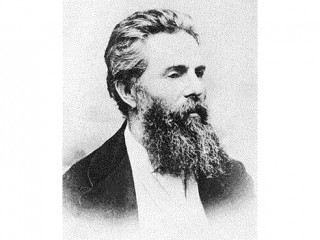
Herman Melville biography
Date of birth : 1819-08-01
Date of death : 1891-09-28
Birthplace : New York City, New York, U.S.
Nationality : American
Category : Arts and Entertainment
Last modified : 2010-05-12
Credited as : Sea story novelist snd travelogue, Moby Dick novel, Redburn
Although he wrote his masterpiece Moby Dick in mid-career, Herman Melville found that some of his books would receive great critical acclaim, while others, which he considered masterpieces, would go unnoticed. Some of his books sold well, but his later books in verse and poetry, often political or melancholic didn’t fare as well. His friendship with writer Nathaniel Hawthorne kept his interest in art alive, but his own struggles seemed to plague him.
Young Herman came from a long line of political dissidents from England – his grandfather had been involved in the Boston Tea Party and another relative was known for defending various forts in New York against the British. He attended Male High School and then the Albany Academy. Following, he worked as a bank clerk and then aided his brother and uncle in various tasks, including fur trading and farming. Herman was able to attend the Albany Classical School and became a teacher, but soon left due to the great unhappiness it brought him.
By the time he had begun teaching, Melville had already been writing and always had a desire to explore. With the family facing some dire financial problems, Melville became a cabin boy on a merchant ship sailing to Liverpool. While he made some money on the vessel, he still had help from relatives in order to survive. By the mid 1800s, he decided to sail on a whaling mission to the South Seas. His adventures on the French Polynesian islands became the subject matter of his first book, called Typee.
In Herman Melville’s second book Omoo, which has been found to be more biographical than his previous, he discusses his capture and escape from a jail in Tahiti due to his and his shipmates’ mutiny against the captain and crew. After a few other attempts at sea voyages, he went back to his family where he decidedly wrote down his adventure tales as narratives. These books did well enough to bring him enough income to support his family. In Melville’s subsequent book, entitled Mardi, he was able to begin working with literary journals that sought contributors to critique existing works. This work didn’t receive the kind of following that Melville would have hoped, so his publisher released another two novels, one called Redburn and another called White-Jacket, which did particulary well.
With the success of his books, he bought a farm near Nathaniel Hawthorne and the two talked much about their writing lives. While on the farm, he wrote Moby Dick; the book did well, but wasn’t as successful as any would have liked. Eventually, Hawthorne moved and the two writers distanced themselves from each other. Melville wrote a few more books and toured both England and Europe, which supplied him with material to write The Confidence Man. In his later years, Melville became more reclusive, but still released new works that are regarded as great works of the American literary canon to this day.
















